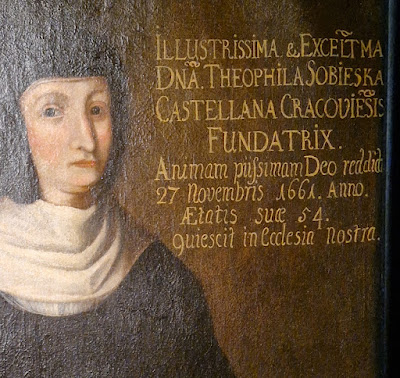There is an interesting museum in the cloisters of the Dominican
church in Cracow. I mean it is interesting if you are either into
history of the Dominicans or into calligraphy. There are some
documents pertaining Dominican history here, they are of course
mediaeval and written in the best hand. They are examples of official
documents hand of the time. The first is so called "passport of
st. Jacek", a letter explaining his credentials to whoever may
be concerned (he was sent by the pope to organise the Dominican order
in Poland). The second, of almost the same date, is the document
permitting the Dominicans to build their church in Cracow. The third,
a century later, is a document establishing the papal inquisition in
Cracow. There also is a missal written for a pope, of course also in
the best hand possible. It is an example of texture capitalis
quadrata in the best version,
although apparently created late for this style.
There are also examples of later
styles. Apparently in the 17thcentury in Poland there was a custom of
writing on the pictures, an information of who is on the picture
would be written on it, not always in the best hand but in the style
of the times. The styles are capitalis minumentalis with antiqua and also some corsiva, of
course written by hand with a brush. They seem to have been written
with a relatively wide brush held so that vertical lines would be
thicker than the horizontal ones.
I also found a picture from the 19th
century with descriptions of what is on the picture in quite a good
hand of the time. In fact I wander how it was written there. It
appears to be a style of hand writing taught at schools at the time,
with a steel nib, which pressed when writing vertical strokes would
produce a thicker line. But how it was done on an oil painting?
 |
| "Passport" of St. Jacek (also called St. Hiacynth),1227 |
 |
| Charter of the Dominican monastery in Cracow, 1227 |
 |
| Charter of the papal inquisition in Poland, 1327 |
.jpg) |
| Life of St. Jacek, 1360 |
.jpg) |
| Papal missal, 1570 |
.jpg)
.jpg)
.jpg)
.jpg)
.jpg)
.jpg)
.jpg)
.jpg)
.jpg)
.jpg)
.jpg)
.jpg)









.jpg)
.jpg)
%20-%20Copy.jpg)
.jpg)
.jpg)
.jpg)

.jpg)
.jpg)

.jpg)
.jpg)
.JPG)
.JPG)
.JPG)


.jpg)
.jpg)
.jpg)
.jpg)
.jpg)
.jpg)
.jpg)
.jpg)
.jpg)
.JPG)
.JPG)
.JPG)
.JPG)
.JPG)
.JPG)
.JPG)